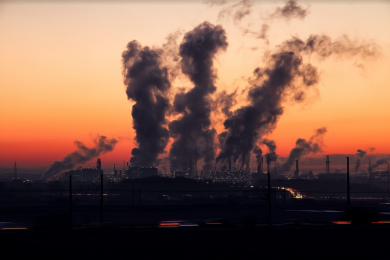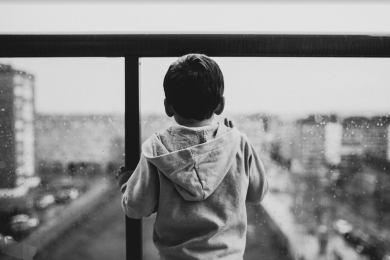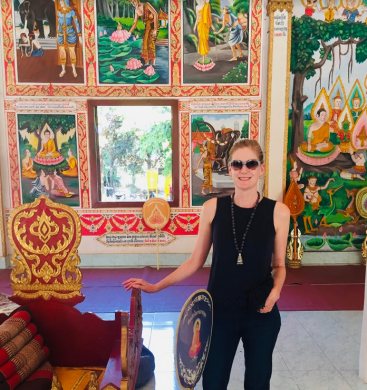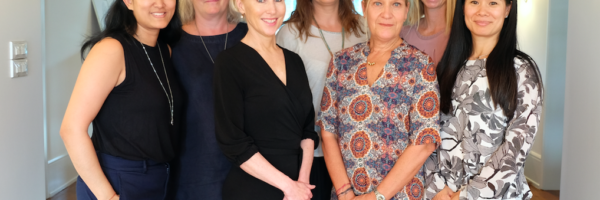
Bangkok Air: How pollution affects our health and what to do about it

Expat. Wife. Mother. Writer. Yoga enthusiast. Clean air awareness advocate and NGO co-founder. The last one I never could have predicted when I took a hiatus from my career in branding and corporate communications to focus on my young family and our move from New York City to New Delhi and then years later on to Bangkok.
Air pollution only consciously entered my life a decade ago. When one lives in a place where the air is clean or appears to be so, air pollution doesn’t cross the mind. It was 2009, the year we moved to India that I first took notice and gave consideration to the air we breathe. I soon learned a new language, the acronyms and lingo of air pollution. PM 2.5 and nanoparticles. AQI, VOC’s, NOx and ozone. True HEPA versus HEPA Type. Prior to that, I thought of air pollution only perhaps when stuck in traffic behind a truck expelling dark exhaust. Soon clean air, or the lack of, began to consume my thoughts year-round. The sky was often a murky haze. Clouds never appeared distinct or sharply formed. The media buzzed about the colloquially-dubbed “winter fog” as if the smog didn’t exist at all. But the facts seemed indisputable. The air we were breathing somehow tasted metallic on the tongue, caused cancelled flights and delayed trains and left city residents with endless weeks of dull headaches and eyes so irritated it was impossible to wear a single contact lens.
Eventually, every member of our family of five had persistent, season-arching coughs. Then it was shortness of breath and finally the inhaler for our eldest. Some days the problem was very apparent, the pollution causing poor visibility that made road signs a hazy mirage. Other times, it was invisible, the air seemed ok, crisper, yet local air quality monitors revealed unhealthy numbers far above international guidelines. The government launched a series of half-hearted attempts to reduce the problem. Odd-even license plate driving initiatives for a few days at a time. Street cleaning programmes. Schools created air pollution protocols around student outdoor activity. Pollution masks should be worn if children want outdoor recess time when the air quality index (AQI) hit certain numbers. No wait! AQI numbers suddenly spiked exceeding those thresholds, schools would declare – no outdoor time at all! Dinner party talk no longer buzzed about local gossip and cultural events, but what to do – stay inside all weekend? Leave town every holiday for clean air breaks? Football games, on or off? Air pollution masks, home filters and car air filters became such coveted, must have items they were perpetually sold out. It was worrying and exhausting.
When we had the opportunity to relocate to Bangkok by 2016, we were thrilled. After years of a dance that toggled between denial, awareness and advocacy, plus makeshift coping measures, we relocated from arguably the world’s worst ranked city for air pollution to another Asian mega-city. Of course, Bangkok’s air, along with much of Thailand, is far from ideal, especially during the months of December to February when meteorological conditions curtail the dispersion of air pollutants. A Lancet report found that people in 90% of the world’s cities breathe polluted air that is toxic to their cardiovascular and respiratory health. In 2016, seven million people died from diseases caused by air pollution – 600,000 of them were children. Seven million people: That’s three times the number of people who die each year from AIDS, tuberculosis and malaria combined.

Bangkok, and Thailand in
A recent air pollution forum hosted by the esteemed International School of Bangkok featured an expert speaker who stated, “This year air pollution is not worse, it’s better than last year.” Ordinary residents of Bangkok might disagree. It feels worse. It looks worse. For the first time in known history, the government shuttered more than 400 schools for several days across greater Bangkok in late January.
Even gorgeous Chiang Mai’s reputation suffered recently as the northern province was featured on the global “worst air” list in mid-February. It was ranked as having the third most polluted air in the world after Delhi and Lahore when PM 2.5 spiked over 100 microns per cubic metre.
So, what is going on with Bangkok’s air?
The cooler months from December to late February aggravate the situation. Cooler temperatures and changing meteorological conditions “trap” air pollution preventing easier dispersal. But what is causing
Why it matters – the impact on our health
Clean air is essential for our health and longevity. PM 2.5 puts our entire bodies at risk of major health issues. When these tiny particles are inhaled through the nose or mouth they enter the respiratory system and bloodstream. The smaller the particle, the farther into the body they penetrate. Given PM 2.5 particles are only a tiny fraction of the width of a human hair, they are invisible to the eye and capable of being small enough to pass through the hairs of the nose. The adverse effects of air pollution can be seen quickly or over many years from extended exposure: shortness of breath, asthma, throat irritation, pneumonia, stroke, heart disease, lung disease, cancer and more. Studies even link air pollutions impact on cognitive function, brain development, and the list goes on. According to Unicef, early exposure to toxic air has lifelong consequences. Children are especially vulnerable given small body size and their developing lungs and brains. Children breathe more air per kilo of

What can you do on a day-to-day basis to lessen exposure?
Can we even protect our family’s health from the most ubiquitous of elements – air? It is possible to take several measures to reduce exposure, especially on the bad air days. First recognising the problem is a major positive step. This enables us to look at the options, at ways to mitigate the damage unhealthy air can have on our family. A combination of lifestyle changes and protective intervention measures can make a big difference.
(1) Monitor and be aware!
Check air quality apps to see current pollution levels via sites like AirVisual on a daily basis. Many Bangkok schools also have recently installed their own air quality monitor systems with data available online. Be aware, however, most of these type of monitors –
(2) Reduce exposure on “bad” air days and at peak times.
For example, rush hour rides in
(3) Talk to your child’s school.
The parents of many Bangkok city schools have voiced alarm about air pollution, petitioned for air monitoring systems on campus and asked about what can be done to improve conditions. Parents can ask their schools to monitor air quality both inside the classroom and the outside facilities. They can encourage coaches to adjust outdoor sports and activity timing to help limit exposure during peak unhealthy air times. This may mean reduced aerobic activities during early morning and evening times, especially during the winter months. Ask schools to work on creating “idle-free zones” on the streets outside the school gates to reduce “pollution hot spots” in the places where the children walk and wait on a daily basis.
(4) Make your home a “clean air” sanctuary.
Indoor air can be as unhealthy as outdoor air. Exterior air pollution combined with indoor pollution sources from furniture varnish, paint, carpets, home printers and more can result in shockingly poor indoor air quality. To improve conditions, evaluate doors and windows to reduce drafts and leakage. Consider investing in air filtration machines for the home. Be sure to invest in only those that have True HEPA filters as only they can remove PM 2.5 particles from the air. These units can be costly, so start with the bedrooms. By using a
(5) Consider an anti-pollution mask, with caution.
To mask or not to mask? Filtering the air you breathe would seem to decrease exposure, yet a mask must fit properly to be effective at all. Masks need to be NIOSH approved, as in 3M
Air pollution is bad for the environment, bad for our health and a drain on economic development. I wonder when we will take more substantive measures to tackle the problem. Let’s change that. If not for our own health, for the children.



